IRP Graduate Students Show Off Their Work at Annual Symposium
Event Highlights Efforts of Early-Career Researchers
The IRP’s reputation as a leader in biomedical research attracts scientists in all stages of their careers and from all corners of the U.S. and the world. Once a year, the motley collection of graduate students who are completing their Ph.D. research in NIH labs gets to tout its scientific accomplishments at NIH’s Graduate Student Research Symposium, which took place this year on February 15.
During the event’s two poster sessions, more than 120 IRP graduate students presented the results of their research so far, from the development of better ways to grow retina-like collections of cells in the lab to insights into how the brain regulates feelings of hunger. Read on for a brief look at a few of the IRP’s brilliant budding scientists and the discoveries they showed off at the event.
Yasmin Padovan-Hernandez: Homing in on Hunger
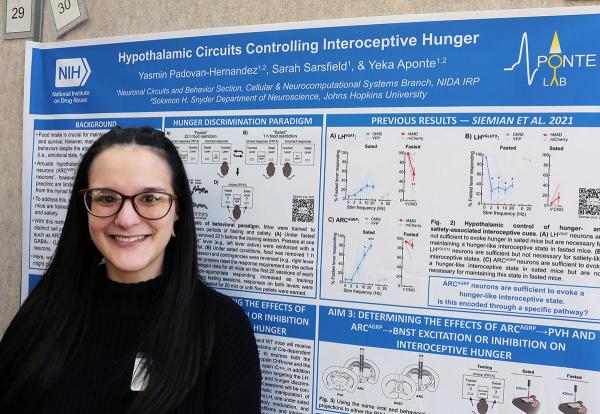
Yasmin has always wanted to open up the black box of behavior, but she only became aware of the field of neuroscience for the first time in a high school psychology class after moving from Brazil to Florida. That experience, combined with memories of passing by cocaine users in the streets of her Brazilian hometown, spurred a desire to use the tools of neuroscience to learn about how addictive substances affect the brain.
“In Brazil, we have a really big issue with crack cocaine,” Yasmin says. “That was the main drug that was around when I was growing up there. Especially later in the evening, if I would go out with my parents in the neighborhood, I would see people sitting on the corners, and I remember the sound of people smoking crack. I would wonder what was going on and my mom wouldn’t say, and later, when I got older, I realized what was going on. That was something I carried with me for a long time.”
After enrolling in a community college in Florida, Yasmin finished her undergraduate studies at the University of Florida, where she worked in a lab studying cocaine use. Now, as a graduate student at Johns Hopkins University in Baltimore, Maryland, she has expanded her interests from drugs like cocaine to the broader topic of behaviors people engage in that harm their health, including over- and under-eating. In the lab of IRP senior investigator Yeka Aponte, Ph.D., Yasmin is studying a specific type of neuron in a brain area called the hypothalamus that is thought to play a role in regulating ‘homeostatic hunger.’ This variety of hunger is spurred by an actual need for energy from food, rather than the desire to eat something that tastes good.
“Once you see food or you smell food or anything like that, there’s a quick inhibition of those neurons, and it’s also scaled to the food’s caloric content, which I think is really interesting,” Yasmin explains. “We’re looking at how those cells actually regulate homeostatic hunger: not just hunger triggered by somebody putting dessert in front of you after dinner, but we want to know what is actually underlying that state of caloric need and how that is being processed in the brain.”
By solving that puzzle, Yasmin and her labmates hope to provide insights that can be used to help people who struggle with eating, whether it’s people with obesity who eat too much or people with anorexia who eat too little.
“Having a better idea of what is going on in a normal state, as a baseline, is really important for us to be able to contrast with what happens when something goes wrong,” she says.
Out of all the perks of doing research at NIH, Yasmin has been struck in particular by how supportive people are of one another in the IRP, energetically tossing ideas back and forth and enthusiastically attending lectures or poster presentations given by their colleagues.
“I love how collaborative people are,” Yasmin says. “I know a lot of institutions like to say they’re collaborative, but when you really look at them, they aren’t really. You might need something and there’s no one to reach out to, or that’s something that people frown upon. Here, it’s almost automatic — you barely have to think about it. I often see people walk into each other’s labs just to see what’s going on, and we’re constantly testing stuff for other people and other people are testing stuff for us. That’s been really great to see.”
“People just seem happy here,” she continues. “It’s been a really nice change to see people be happy and collaborative.”

Fun fact: Yasmin recently started learning to crochet. One of her most recent creations is a crochet turtle named Emilio. She particularly enjoys crocheting while hanging out with her cat, Lyra. “If my cat is sitting on my lap while I’m crocheting, I’m the happiest girl alive,” she says.
Kenya DeBarros: Making Medicine From Melons
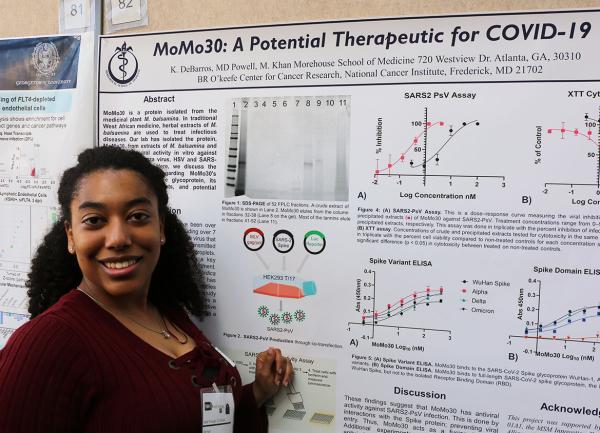
Growing up, Kenya was a “performing arts kid,” she says, with science being “just a subject that I was good at in school.” However, that started to shift when her mother enrolled her in a magnet program focused on research and medical science so that she could attend the high school closest to her home.
“Our program was basically pre-med bootcamp, so I was surprised to find out that I was actually good at it,” Kenya recalls.
In college at the University of Georgia, learning about the anti-malarial drug artemisinin, which comes from the sweet wormwood plant, inspired her to try her hand at studying the medical applications of chemicals found in the natural world. When she began her Ph.D. in Biomedical Sciences at Morehouse School of Medicine in Atlanta, she focused that interest on MoMo30, a chemical found in a type of bitter melon used by traditional healers in the West African nation of Senegal.
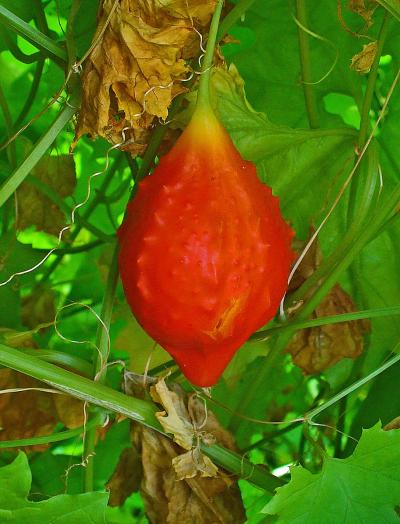
MoMo30 comes from the Senegalese bitter melon (Momordica balsamina), pictured here. Image credit: H. Zell via Wikimedia Commons
Kenya’s lab at Morehouse had started out investigating MoMo30’s applications to treating HIV/AIDS, but because Kenya started her Ph.D. research as the COVID-19 pandemic began, she instead ended up studying its potential as a treatment for COVID-19. When she came to NIH to work with IRP senior investigator Barry O’Keefe, Ph.D., she continued that work, ultimately discovering that MoMo30 can stick to the spike proteins that the novel coronavirus uses to enter our cells.
“What that would mean for a COVID patient is if they took MoMo30 as a drug, it might stop the virus from infecting their own cells so that they can recover,” Kenya explains.
“Knowing this wouldn’t just help treat COVID patients,” she adds, “but it could also give us more understanding of how coronaviruses work, how other viruses work, and how we can treat them when another pandemic comes along.”
Now that she is preparing to graduate with her Ph.D., Kenya looks forward to seeing MoMo30 move closer to tests in live animal models and, eventually, clinical trials in humans. However, she will certainly never forget the scientific skills she gained at NIH and the bonds she forged with the people who taught them to her.
“My experience at NIH has been my most positive lab experience,” she says. “I worked with nice people who were all very helpful and always had great stories to tell.”
Fun fact: Kenya has been playing the violin since she was eight years old. As an undergraduate, she minored in Music Performance with a focus on the violin and performed in several musical ensembles, including the University of Georgia Symphony Orchestra.
Kyle Schwab: Using Bioengineering to Improve Retina Research
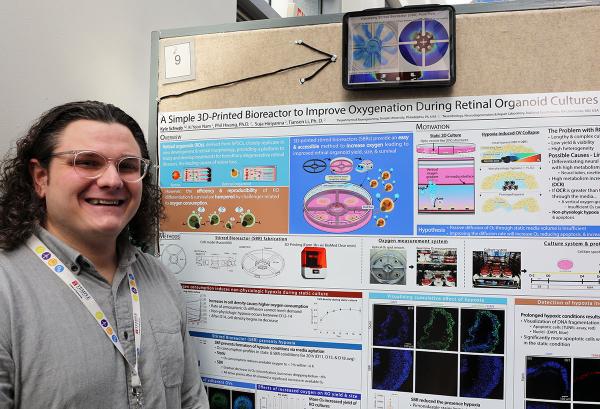
Kyle is one of many people who have sunk countless hours into experimenting with 3D printers, but he may be unique in that the hobby changed the trajectory of his life. After working in a pharmacy for a few years and beginning the required classes to eventually become a licensed pharmacist, his discovery of 3D printing technology caused him to reconsider his career goals.
“Just before applying to pharmacy school, my best friend and I purchased a 3D printer and we developed a healthy obsession,” Kyle recalls. “Having enjoyed my science-related courses and with a newly found passion for 3D printing, I researched what career paths would allow me to continue learning in these fields. Bioengineering was at the top of that list, so it was an easy decision.”
Now a graduate student in Bioengineering at Temple University in Philadelphia, Kyle is leveraging his enthusiasm for engineering to help IRP researchers improve the way they grow three-dimensional collections of cells that closely resemble the human retina, known as retinal organoids. The main challenge he is tackling in the lab of IRP senior investigator Tiansen Li, Ph.D., is the organoids’ insatiable need for oxygen, a lack of which can hinder their growth. By developing miniature 3D-printed bioreactors that provide more oxygen to the growing cells, Kyle hopes to help his labmates produce larger and more robust retinal organoids in greater quantities.
“Current animal models often inadequately represent human retinal physiology, hindering our understanding of retinal development and diseases,” he says. “By developing specialized bioreactors and biomaterials to improve retinal organoid production, we can provide more accurate models for research, leading to better insights and potential therapies.”
“This advancement could accelerate research into retinal development and diseases, leading to more effective treatments and personalized therapies for patients suffering from conditions such as retinitis pigmentosa and age-related macular degeneration,” he adds. “Additionally, these organoids could serve as invaluable tools for drug screening, ultimately expediting the development of new therapeutics for retinal disorders.”
As an engineer, Kyle could easily have stumbled when it came to working in a lab more focused on biomedical research. However, he has found himself “surrounded by extremely knowledgeable and passionate postdocs and investigators” who have helped him apply his skills to improving human health — perhaps once again permanently altering what he envisions for his future career.
“Being the only bioengineer in a lab full of biologists has been my favorite part of being at NIH because I’ve been inundated with amazing ideas that require the development of specialized devices or tools that don’t exist,” Kyle says. “I then get to design, fabricate, and immediately test these ideas with my colleagues. For me, there is no better sense of accomplishment.”
Fun fact: In his spare time, Kyle enjoys building compost bins to generate his own nutrient-rich soil, which he then uses to grow flowers and vegetables.
Yizhen Zhang: Parsing the Brain’s Pain Dial

Growing up in Maryland’s Montgomery County, where NIH’s main campus is located, gave Yizhen the opportunity to get an early start on her IRP journey. During high school, she worked as a summer intern in the lab of IRP senior investigator Wei Li, Ph.D., where she studied how the eye’s retina perceives the color blue. The experience was the culmination of a childhood spent “getting my hands dirty to probe the world around me,” she says. It also gave her a head start in the field of neuroscience, a subject she has long been fascinated by.
“Understanding how the brain works, especially how it changes our various sensory perceptions, has always been very interesting to me,” she explains. “We all perceive the world slightly differently due to differences in our circuits, resulting from nature and nurture. It also occurs within an individual depending on a variety of factors ranging from mental and physical states to different disorders and stages of our lives. I am fascinated by how the brain can so dynamically and strongly modulate our sensory perceptions.”
After finishing her undergraduate double-major in Cognitive Science and Molecular and Cell Biology — along with a minor in Global Poverty and Practice — at the University of California, Berkeley, Yizhen returned to NIH as a participant in the Postbaccalaureate IRTA program. This time, she opted to join the lab of IRP senior investigator Mark Hoon, Ph.D., so she could study a form of sensory perception outside the realm of vision: pain.
“Pain is perceived in the brain and is subject to a wide variety of modulation,” Yizhen says. “Since pain can be so drastically altered because of external and internal factors, I am very curious about what circuits in the brain are able to accomplish this and how they do it.”
When it came time to pursue a Ph.D. in Neuroscience from Brown University, Yizhen decided to remain in Dr. Hoon’s lab, where she is now examining how certain neurons in the brainstem affect the perception of pain. So far, she has found that there are multiple subtypes of those neurons, and altering the activity of one particular type appears to dial up pain perception in mice so that normally innocuous stimuli, like the gentle brush of a feather, can become unpleasant.

Yizhen’s research could help shed light on why even the touch of something soft can be painful for some people.
“Hopefully, my project can contribute to future work to create pain therapies with improved effectiveness and specificity while minimizing side effects and addiction,” Yizhen says.
As someone who loves to learn in a hands-on way, Yizhen has been thrilled to continue her scientific journey as an IRP graduate student. Throughout her time at NIH, she says, she has had “amazing mentors” who have “taught me not just techniques but also opened the door to more ways of thinking, tackling questions, reading critically, and doing better science.” Those mentors, and the unparalleled resources provided by the IRP, have enabled her to learn about the mysteries of the brain in a way that few people ever get to experience.
“Besides learning, few things can compete with the joy of being in the lab doing an experiment,” she says.
Fun fact: “I like hobbies that challenge me,” Yizhen says, and she enjoys caring for exotic plants, running long distances, and experiencing other cultures through food.
Jonathan Nicklas: Scrutinizing A Dangerous Skin Fungus
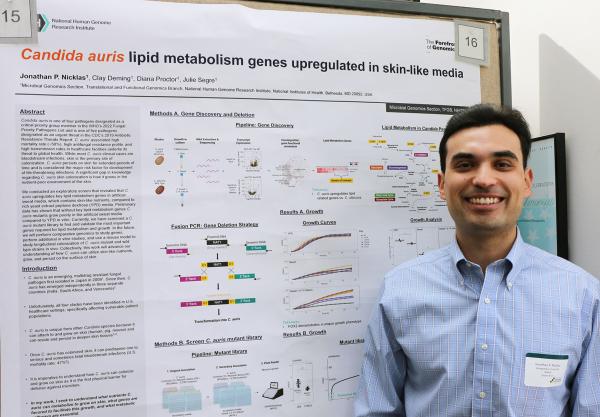
Jonathan has spent the past decade pursuing his passion for organisms from birds to bacteria. He first dove into the world of scientific research as an undergraduate at the University of Scranton in Scranton, Pennsylvania, where he studied sex differences in feather colors between female and male Gray Catbirds.
“Back then, I was fascinated by Charles Darwin’s famous theory of biological evolution by natural selection,” he says. “I was even more fascinated that Darwin could discern his theory by simply observing Galapagos finches.”
Now that he is enrolled in a Ph.D. program at Georgetown University in Washington, D.C., Jonathan is learning about a much smaller species in the lab of IRP Distinguished Investigator Julie Segre, Ph.D. There, he has been studying the Candida auris fungus, which has been a thorn in doctors’ sides since its discovery in 2009 due to its resistance to many antifungal drugs.
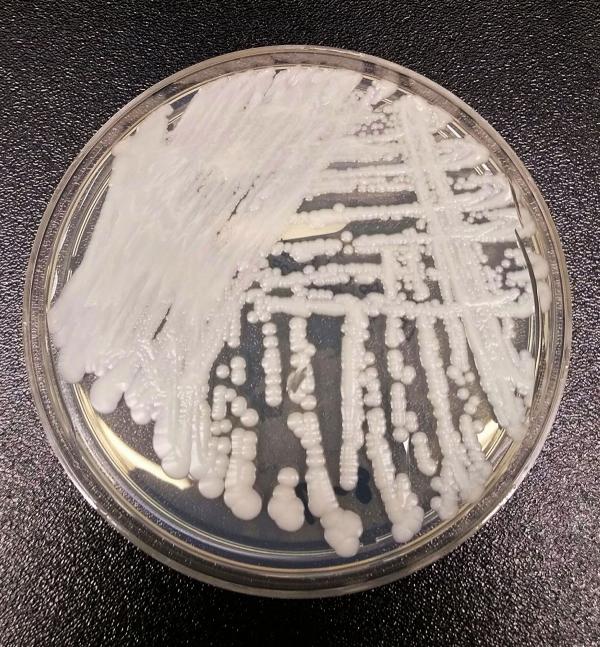
Candida auris growing in a petri dish.
“This fungus can cause severe illness and spreads easily among patients in healthcare facilities,” Jonathan explains. “C. auris can grow on human skin to high density for at-risk patients. This is problematic because skin colonization can predispose them to life-threatening bloodstream infections that are extremely difficult to treat.”
Jonathan is specifically trying to figure out which nutrients on our skin the fungus uses to fuel its growth, as well as the genes and biochemical processes that underlie that process. While identifying the fungus’ favorite snacks may seem unimportant, understanding such a fundamental aspect of C. auris’ biology would be a boon to the patients it affects.
“If we could understand this, then we could develop new treatments to mitigate skin colonization and growth before a serious infection can happen to ultimately save lives,” Jonathan says.
Jonathan’s start as a graduate student was unfortunately thrown into chaos by another microscopic threat, COVID-19. However, as things have become more normal over the past couple years, his experience has significantly improved. At NIH, he has learned from scientists at all levels of experience from postbaccalaureate fellows fresh out of undergrad to senior investigators leading IRP labs.
“My favorite part of being a graduate student, specifically at the NIH, is how I can always manage to find someone to help me in any capacity whether it is science-related, career-related, or simply for advice,” Jonathan says. “NIH is a remarkable institution because it is full of great people who make it a privilege to work there!”
Fun fact: As an undergraduate, Jonathan majored not only in Biology but also Western Philosophy, which involved learning about philosophical teachings stretching back from the modern day all the way to ancient Greece. “Both fields were essential to my continual development as a scientist and person,” he says.
Subscribe to our weekly newsletter to stay up-to-date on the latest breakthroughs in the NIH Intramural Research Program.
Related Blog Posts
This page was last updated on Tuesday, March 5, 2024
